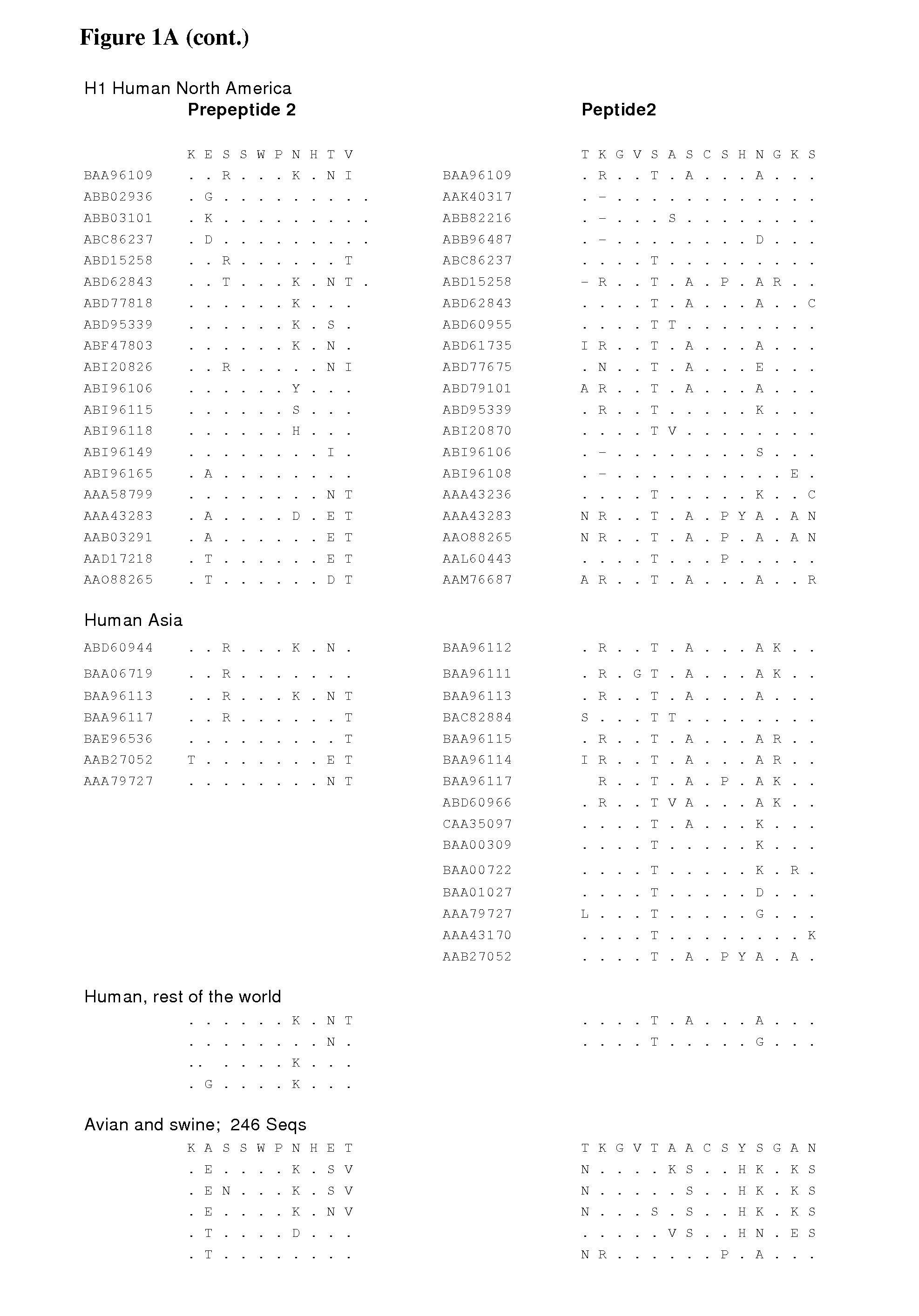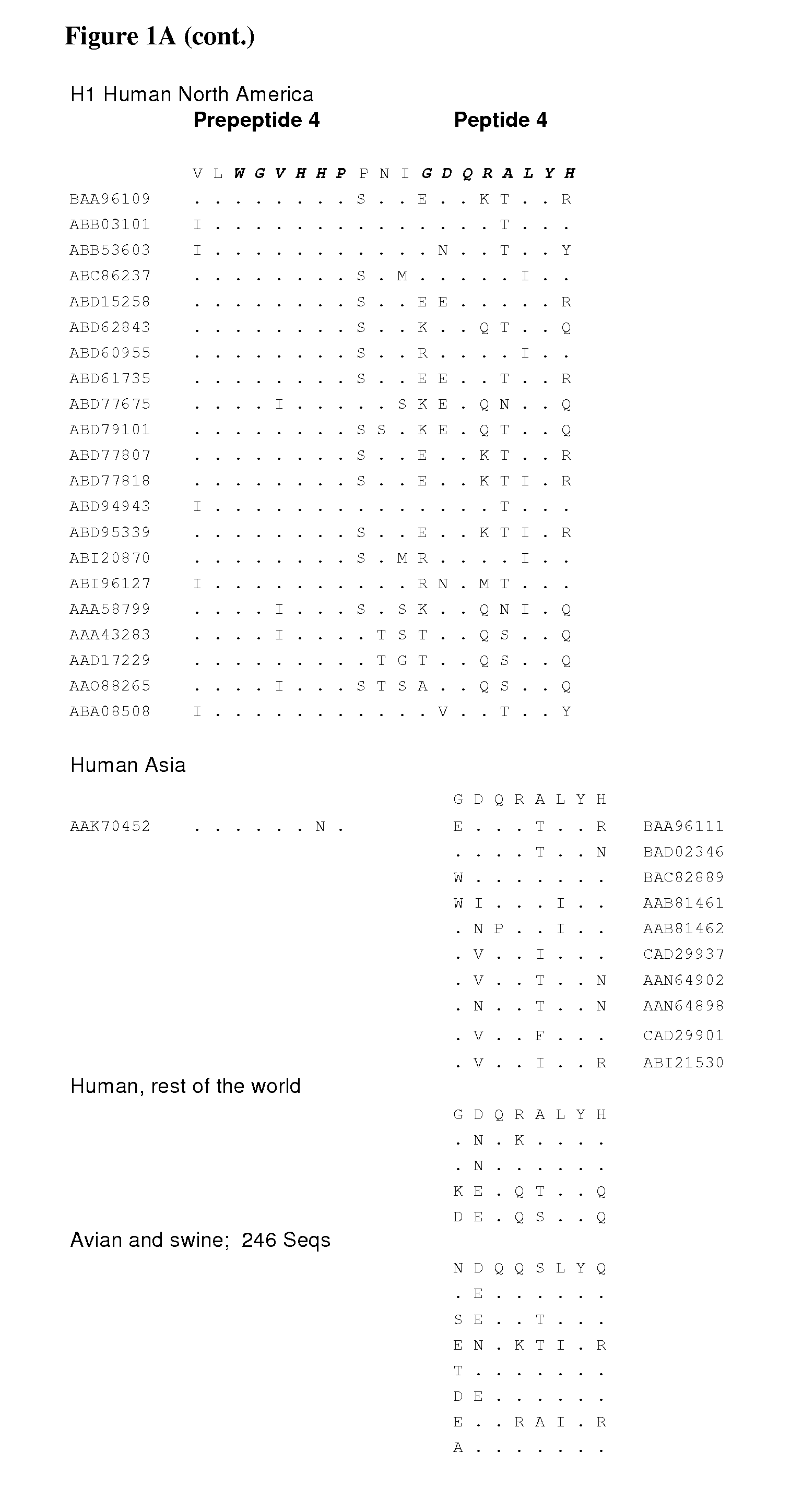Peptide vaccine for influenza virus
a technology of peptides and vaccines, applied in the field of peptide vaccines for influenza viruses, can solve the problems of infection, pandemia, high morbidity and mortality rates, and the difficulty of stopping the outbreak of an easily spreading influenza virus
- Summary
- Abstract
- Description
- Claims
- Application Information
AI Technical Summary
Benefits of technology
Problems solved by technology
Method used
Image
Examples
example 1
Modeling Studies of the Influenza Hemagglutinin
[0515]Introduction—The X-ray crystallographic structure of the hemagglutinin of the X-31 strain of human influenza virus was used for the docking (PDB-database, www.rcsb.org / pdp, the database structure 1HGE). The structure used in the modelling is a complex structure including Neu5Acα-OMe at the primary sialic acid binding site, the large oligosaccharide modelled to the site had one Neu5Acα-superimposable to the one in the 1HGE, but glycosidic glycan instead of the methyl group. The studies and sequence analyses described below in conjunction with hemagglutination-inhibition studies used for evaluation of the binding efficacy of the different branched poly-N-acetylactosamine inhibitors.
[0516]In addition to the primary site, which binds to both sialyl-α3-lactose and sialyl-α6-lactose, a secondary site exists which has been previously found to bind sialyl-α3-lactose as well but not sialyl-α6-lactose. The present conformational peptide 3 a...
example 2
Assays With 2 Immobilization Chemistries
[0517]Materials and Methods for ELISA Assays of Peptides
[0518]ELISA Assays on Maleimide-Activated Plates
[0519]Peptides containing cysteine were bound through the cysteine sulfhydryl group to maleimide activated plates (Reacti-Bind™ Maleimide activated plates, Pierce). The peptides sequences were as follows:[0520]Biotin-aminohexanoyl-SYACKR (custom product, CSS, Edinburgh, Scotland)[0521]Biotin-aminohexanoyl-SKAYSNC (custom product, CSS, Edinburgh, Scotland)[0522]CYPYDVPDYA (HA11; Nordic Biosite)
[0523]All peptides were dissolved in 10 mM sodium phosphate / 0.15 M NaCl / 2 mM EDTA, pH 7.2, to a concentration of 5 nmol / ml. One hundred microliters of the peptide solution (0.5 nmol of peptide) was added to each well and allowed to react overnight at +4° C. The plate was then washed three times with 10 mM sodium phosphate / 0.15 M NaCl / 0.05% Tween-20, pH 7.2).
[0524]The unreacted maleimide groups were blocked with 2-mercaptoethanol: 150 μl of 1 mM 2-mercap...
example 4
[0561]Multiple alignment of amino acid sequences from various HA subtypes and hosts.
[0562]Altogether 158 sequences and 788 sequences were used for the analysis. In some cases all peptide sequences of a subtype were aligned in groups of 200-400 sequences. The sequences were aligned using Influenza Virus Resource alignment tools and the variant amino acids were visually observed within the peptide regions of the invention.
[0563]Comparisons were also made within an HA subtype by aligning each HA subtypes and observing variation in the peptide regions of the invention.
PUM
| Property | Measurement | Unit |
|---|---|---|
| non-covalent interaction | aaaaa | aaaaa |
| length | aaaaa | aaaaa |
| structures | aaaaa | aaaaa |
Abstract
Description
Claims
Application Information
 Login to View More
Login to View More - R&D
- Intellectual Property
- Life Sciences
- Materials
- Tech Scout
- Unparalleled Data Quality
- Higher Quality Content
- 60% Fewer Hallucinations
Browse by: Latest US Patents, China's latest patents, Technical Efficacy Thesaurus, Application Domain, Technology Topic, Popular Technical Reports.
© 2025 PatSnap. All rights reserved.Legal|Privacy policy|Modern Slavery Act Transparency Statement|Sitemap|About US| Contact US: help@patsnap.com



